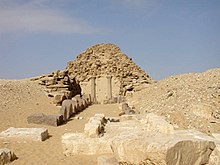
Abusir (also spelt Abu Sir) is the name given to an Egyptian archaeological locality on the desert plateau (and its neighbouring village in the valley) 10 km (7 miles) south of Giza and 8 km north of Saqqara. About 35 km south of the Egyptian capital Cairo, Abusir is the site of a compact pyramid field, with pyramids and funerary temples dating mainly from the 5th Dynasty of the Old Kingdom. It is somewhat "off the beaten track" for most visitors and therefore ideal for exploration with far less hassle and company than will be experienced at Giza, or even Saqqara.
Understand
edit- See also: Ancient Egypt
Just one, relatively small segment of the extensive "pyramid field" that extends from north of Giza to below Saqqara, the locality of Abusir took its turn as the focus of the prestigious western burial rites operating out of the then-capital of Memphis as an elite cemetery (or necropolis) during the Old Kingdom 5th Dynasty. Neighbouring Giza had by then "filled up" with the massive pyramids and other monuments of the 4th Dynasty, leading the 5th Dynasty pharaohs to seek sites elsewhere for their own funerary monuments. Although two 5th Dynasty pharaohs (Unas and Userkaf) did build their pyramids further south at Saqqara, adjacent to the 3rd Dynasty Step Pyramid of Djoser, most of the Dynasty's rulers concentrated their efforts at Abusir (for their pyramids and associated funerary temples) and elsewhere (for their so-called "sun-temples").
Get in
editAbusir is closed for tourism (as 11/2024), you are only permited to take a picture at distance.
Abusir is not served by any viable means of public transport, the site lying some distance from the village and the main road that leads south to Saqqara. The only practible means of visiting Abusir are by car, by hired taxi (perhaps in association with a visit to Saqqara or Giza) or as part of an organised tour group.
There are local trains from central Cairo to El Hawamdeyya, a few kilometers to the east.
- 1 El Hawamdeyya railway station.
See
edit


The Abusir necropolis is open daily 8am-4pm. Admission LE80 (as of Dec 2018). 14 pyramids were constructed at Abusir - of these, four were those of pharaohs, three of royal women and one unfinished. Some are better preserved than others, from those surviving, but all in a far more ruined state - and certainly built to more modest dimensions - than those found at Giza:
- 1 Pyramid of Sahure. The northernmost pyramid at Abusir and located closest to the entrance to the site, the Pyramid of Sahure (pronounced "Sa-who-ray") - the second ruler of the 5th Dynasty - was also the first constructed at Abusir. Completing its profile as the most completely preserved pyramid at the locality, the Pyramid of Sahure once measured..... Numerous blocks carved in beautiful deep relief were revealed here when the French archaeologist Borchardt excavated between 1902-1908. On the eastern side of the pyramid, the attached mortuary temple is reasonably well-preserved, retaining numerous granite pillars and large blocks with Sahure's cartouche still clearly visible. It is possible to access the pyramid's interior: from the entrance, a 75 m long walk down a corridor leads to the burial chamber, entered by crawling through a narrow portal and 2 m long passage.
- 2 Pyramid of Nyuserre. Easily the most ruinous of the 'complete' pyramids at Abusir. Nyuserre was the son of pharaoh Neferirkare and usurped the causeway of his father's mortuary temple for his own monument - it can be seen to the southeast of the pyramid. Nyuserre's monument encompass a main pyramid, a mortuary temple adjacent the east face, a valley temple on Abusir Lake, the accompanying causeway intended for Neferirkare's monument, and a cult pyramid. The main pyramid had a stepped core built from roughly cut limestone encased in fine Tura limestone. The limestone casing was stripped by stone thieves, leaving the core exposed to the elements and further human activity, reducing the once nearly 52 m (171 ft) tall pyramid to a ruined mound, with a substructure that is dangerous to enter due to the risk of cave-ins.
- 3 Pyramid of Neferirkare Kakai. Standing 45 m now in a partially ruined state, the Pyramids of Neferirkare closely resembles the Step Pyramid of Djoser at Saqqara, unintentionally, as the steps visible in its construction were designed to be filled in to achieve the classic pyramid shape. This task was never completed.
- 4 Pyramid of Raneferef.
- 5 The pyramid of Queen Khentkaus II. Queen Khentkaus II, wife of Neferirkare and mother of Neferefre and Niuserre.
- 6 The unfinished pyramid of Shepseskaf?.
- 7 Lepsius Pyramid no. 24. — The pyramid belonged to a woman, likely a queen. The name of the vizier Ptahshepses appears among builders' marks, which dates the pyramid to the time of Pharaoh Nyuserre.
- 8 Lepsius Pyramid no. 25. Likely the pyramid of a queen from the Fifth dynasty
- 9 Mastaba of Ptahshepses. Ptahshepses, vizier under Nyuserre.
- Mastaba of Prince Nakhtkare. Prince Nakhtkare, son of Raneferef or Nyuserre.
- 10 Sun Temple of Userkaf.
- 11 Sun Temple of Niuserre.
Sleep
edit- 1 Sakkara Inn, Abu Sir (at western edge of village, take the side road to Abu Sir pyramids from Saqqara Road), ☏ +20 109 444 0109, sakkarainn@hotmail.com. Opened in 2016, basic but comfortable guesthouse/hotel with clean rooms near the pyramids of Abu Sir (1 km) and Saqqara (5 km).

